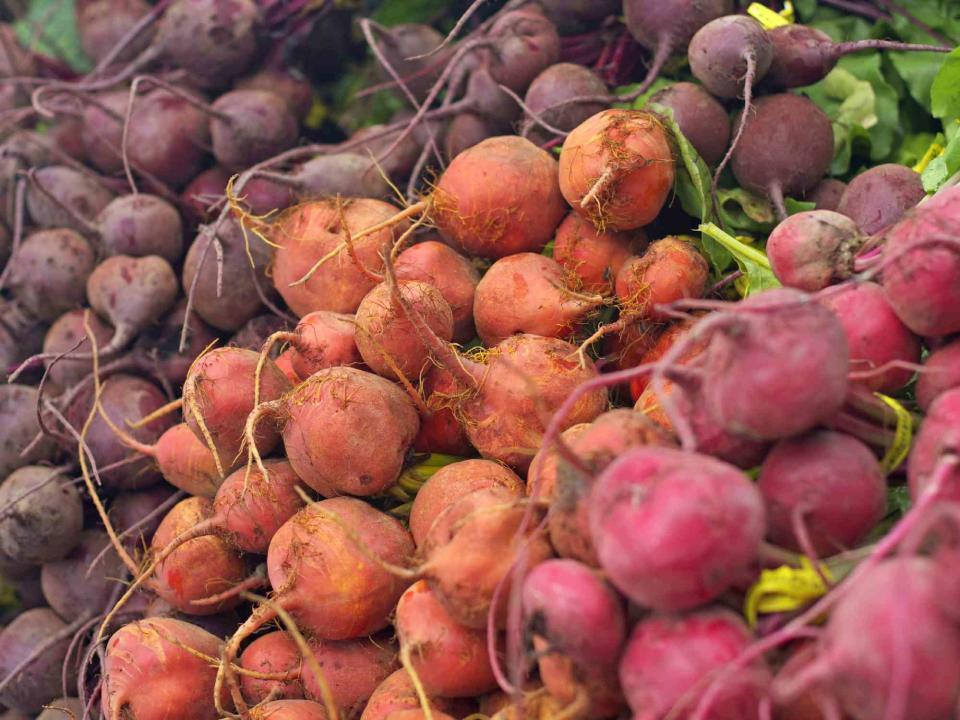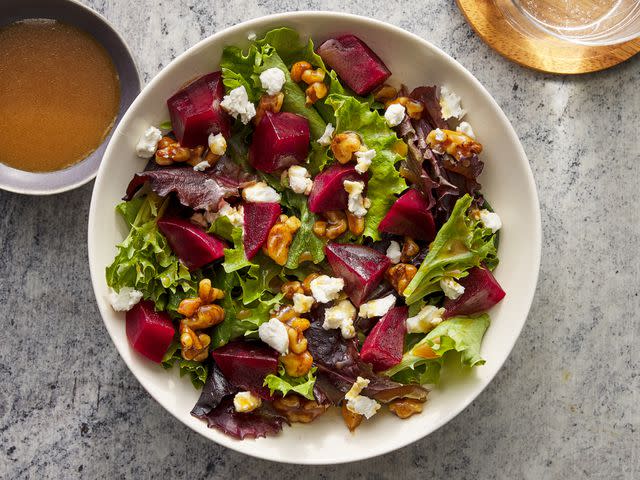The Best Types of Beets for Every Occasion
Fall in love with this misunderstood root vegetable.

As far as root vegetables go, beets aren't the flashiest, but they're just as versatile and delicious as their other root vegetable cousins. If you're a beet lover, you know they're easy to grow, hearty, cheap, and well-suited to most cooking techniques. They're bountiful at stores and farmer's markets starting in June and are usually available all the way through the fall and, in some regions, into the winter.
If you've ever been intimidated by the many varieties lining the stalls at the farmers market, read on for the inside scoop on what they are and how to use them.
Related: How to Store Fresh Beets to Keep Them Fresh for Longer
What are Beets?
Beets are sometimes called beetroot, which is a fitting name since the bulb grows underground with a root attached while the hearty greens spring up from the ground. Beet greens look very similar to chard and can be eaten raw, sliced into very thin ribbons, or cooked like chard, kale, or other hearty greens. T
The red bulb most of us think of when we hear "beets," grows in the soil, just like a carrot. The root is very firm and crunchy and is known for its hand-staining pink juice. Beets are loaded with vitamins and other nutrients like folate, so if you're trying to get more folate in your diet, consider adding beets to your weekly grocery list.
Common Types of Beets
Red Beets
These are the quintessential beet, but did you know that there are tens of varieties of red beets? They're mostly very similar, with one of the most popular and easy to find being the Detroit red beet. When shopping for red beets, look for smaller beets without blemishes. Large beets can be fibrous and not as flavorful. Red beets are incredibly versatile; try them pickled, juiced, roasted, or raw.
Roasted beets blend beautifully into pureed soups, and especially love the company of chickpeas in hummus. Raw beets are an excellent topping for a salad when grated or sliced thinly; this preparation really highlights their earthy flavor.

Dotdash Meredith Food Studios
Get the recipe: Beet Salad with Goat Cheese
Golden Beets
Golden beets are the sweetest variety of beets. They also cook up much softer than most other types of beets. This makes them great for mashing or blending into soups and dips. If you think you don't like beets, give golden beets a chance– they're less earthy and firm than traditional red beets and get impossibly sweet when roasted.
Avalanche Beets
At first glance, you might mistake these off-white beets for turnips. But don't be fooled! Their sweet flavor and absence of turnip's peppery bite will quickly convince you of their beet-ness. They lack the earthiness you expect from red beets and have a milder, sweet vegetal flavor with a crunch that will remind you of a carrot. They're smaller than standard red beets, so they cook much quicker– this, combined with their high sugar content, makes them perfect for roasting alone or in a vegetable medley.
Candy Cane Beets
Also called striped, bull's eye, Chioggia, or Bassano Beets– the latter being the Italian village where they were originally cultivated in the 1800s. Of all the varieties of beets, these are arguably the most beautiful. You'll notice vibrant red and white (and sometimes orange) rings like a delicious bulls-eye when cut open.
These are an heirloom variety, so you'll have more luck finding them at a farmer's market than at the grocery store. They tend to be much smaller than red beets and have juicer flesh with a deep earthy flavor and slight sweetness. The trademark stripes fade considerably and sometimes completely when these beets are cooked, so for the biggest impact, consider shaving them thin in a salad or as a garnish.
How Long Do Beets Last
Beets will last a few days on the counter, at most five. In the fridge, beets will last about ten days. It's easy to tell if your beets are starting to go bad with a quick squeeze. Fresh beets are firm, so if they start to feel soft, use them asap or toss them. Soft beets won't cook up to the best texture, but if you find yourself with a bunch of soft beets that don't show any other signs of spoilage, consider pickling them.
How to Store Beets
Storing beets on the counter is fine if you plan to use your beets in the next day or two. Beets much prefer cool dark areas, a cellar or pantry is good, but the refrigerator is best. Aim to keep your beets at about 40 degrees or below; this will preserve them the longest. If you bought your beets with the greens still attached, congratulations, free salad greens!
Cut the greens off, rinse and dry them, and store them in a zip-top bag or other airtight storage container with a dry paper towel. Beet greens love the crisper drawer and will happily stay there for three to five days. Moisture accelerates spoilage, so try to keep your beets as dry as possible; this means waiting to wash them until it's time to cook.
Read the original article on All Recipes.

